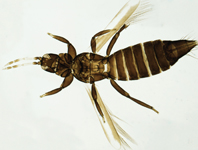Abstract
In the present work, five new species of Xangoniscus are described, increasing to eight the number of the known troglobitic species for the genus. Xangoniscus species can be distinguished from each other by the shape of pleonites epimera, the number and size of aesthetascs in the distal article of antennula, the modifications on pereopods, the shape of male pleopods and the proportion between uropod rami. Species from this genus are known for the states of Minas Gerais and Bahia with Xangoniscus aganju representing the northernmost occurrence, and X. lundi n. sp. and X. dagua n. sp. the southernmost occurrences. Of the six caves where specimens were collected, four are not registered in the national speleological database, what points to all the potential to yet be discovered regarding number of cavities and the associated biodiversity in Brazil. Some of the here mentioned type localities are not located inside protected areas, therefore exposing the species to risks related to the adjacent land use and consequent influence on water table level and input of food resources. The contribution of this work with descriptions of new troglobitic species provides support to consider them as plausible candidates to be assessed in the next list of threatened species as well as to elaborate conservation actions for the species, the caves where they inhabit and the surrounding landscape.
References
Andersson, A. (1960) South American terrestrial isopods in the collection of the Swedish State Museum of Natural History. Arkiv för Zoologi, 12, 537–570.
Arcangeli, A. (1929) Isopodi terrestri raccolti in Cuba dal Prof. F. Silvestri. Bollettino del Laboratorio di Zoologia Generale e Agraria della Regia Scuola Superiore d´Agricoltura in, 23, 129–148.
Bastos-Pereira, R. & Ferreira, R.L. (2017) Spelaeogammarus uai (Bogidielloidea: Artesiidae): a new troglobitic amphipod from Brazil. Zootaxa, 4231 (1), 038–050.
https://doi.org/10.11646/zootaxa.4294.2.11
Bastos-Pereira, R., Souza, L.A. & Ferreira, R.L. (2017) A new amphibious troglobitic styloniscid from Brazil (Isopoda, Oniscidea, Synocheta). Zootaxa, 4294 (2), 292–300.
https://doi.org/10.11646/zootaxa.4294.2.11
Campos-Filho, I.S., Araujo, P.B., Bichuette, M.E., Trajano, E. & Taiti, S. (2014) Terrestrial isopods (Crustacea: Isopoda: Oniscidea) from Brazilian caves. Zoological Journal of the Linnean Society, 172, 360–425.
https://doi.org/10.1111/zoj.12172
Campos-Filho, I.S., Bichuette, M.E. & Taiti, S. (2016) Three new species of terrestrial isopods (Crustacea, Isopoda, Oniscidea) from Brazilian caves. Nauplius, 24, e2016001.
https://doi.org/10.1590/2358-2936e2016001
Campos-Filho, I.S., Bichuette, M.E., Montesanto, G., Araujo, P.B. & Taiti, S. (2017a) The first troglobiotic species of the family Pudeoniscidae (Crustacea, Isopoda, Oniscidea), with descriptions of a new genus and two new species. Subterranean Biology, 23, 69–84.
https://doi.org/10.3897/subtbiol.23.20963
Campos-Filho, I.S., Montesanto, G., Araujo, P.B. & Taiti, S. (2017b) New species and new records of terrestrial isopods (Crustacea, Isopoda, Oniscidea) from Brazil. Iheringia, Série Zoologia, 107, e2017034.
https://doi.org/10.1590/1678-4766e2017034
Campos-Filho, I.S., Fernandes, C.S., Cardoso, G.M., Bichuette, M.E., Aguiar, J.O. & Taiti, S. (2019) Two new species and new records of terrestrial isopods (Crustacea, Isopoda, Oniscidea) from Brazilian caves. Zootaxa, 4564 (2), 422–448.
https://doi.org/10.11646/zootaxa.4564.2.6
Cipola, N.G., Oliveira, J.V.L.C., Bellini, B., Ferreira, A.S., Lima, E.C.A., Brito, R.A., Stievano, L.C., Souza, P.G.C. & Zeppelini, D. (2020) Review of Eyeless Pseudosinella Schäffer (Collembola, Entomobryidae, and Lepidocyrtinae) from Brazilian Caves. Insects, 11(3), 1–141.
https://doi.org/10.3390/insects11030194
Fernandes, C.S., Campos-Filho, I.S. & Bichuette, M.E. (2018) Cylindroniscus platoi (Isopoda: Oniscidea: Styloniscidae), a new cave-dwelling species from Lagoa Santa Karst, Southeasthern Brazil. Zootaxa, 4461 (3), 411–420.
https://doi.org/10.11646/zootaxa.4464.3.6
Fernandes, C.S., Campos-Filho, I.S., Araujo, P.B. & Bichuette, M.E. (2019) Synopsis of terrestrial isopods (Crustacea: Isopoda: Oniscidea) from Brazilian caves, with emphasis on new records from north, midwest, northeast and southeast regions. Journal of Natural History, 53(17-18), 1095–1129.
https://doi.org/10.1080/00222933.2019.1634225
Leal-Zanchet, A.M., Souza, S.T. & Ferreira, R.L. (2014) A new genus and species for the first recorded cave-dwelling Cavernicola (Platyhelminthes) from South America. ZooKeys, 442, 1–15.
https://doi.org/10.3897/zookeys.442.8199
Montesanto, G. (2015) A fast GNU method to draw accurate scientific illustrations for taxonomy. ZooKeys, 515, 191–206.
https://doi.org/10.3897/zookeys.515.9459
Montesanto, G. (2016) Drawing setae: a GNU way for digital scientific illustrations. Nauplius, 24, e2016017.
https://doi.org/10.1590/2358-2936e2016017
Mulaik, S. (1960) Contribución al conocimiento de los isópodos terrestres de Mexico (Isopoda, Oniscoidea). Revista del la Sociedad Mexican de Historia Natural, 21, 79–292.
Prevorčnik, S., Ferreira, R.L. & Sket, B. (2012) Brasileirinidae, a new isopod family (Crustacea: Isopoda) from the cave in Bahia (Brazil) with a discussion on its taxonomic position. Zootaxa, 3452, 47–65.
https://doi.org/10.11646/zootaxa.3452.1.2
Schmidt, C. (2002) Contribution to the phylogenetic system of the Crinocheta (Crustacea, Isopoda). Part 1 (Olibrinidae to Scyphacidae s. str.). Mitteilungen aus dem Zoologischen Museum in Berlin, Zoologische Reihe, 78, 275–352.
https://doi.org/10.1002/mmnz.20020780207
Shear, W.A., Ferreira, R.L., Moretti, L.I. & Marek, P. (2016) A millipede missing link: Dobrodesmidae, a remarkable new polydesmidan millipede family from Brazil with supernumerary rings (Diplopoda, Polydesmida), and the establishment of a new suborder Dobrodesmidea. Zootaxa, 4178 (3), 371–390.
https://doi.org/10.11646/zootaxa.4178.3.4
Silva, A.P.B. da, Oliveira, I.P.M.R., Bastos-Pereira, R. & Ferreira, R.L. (2018) Are laboratory studies on behavior of troglobitic species always trustful? A case study with an isopod from Brazil. Behavioural processes, 153, 55–65.
https://doi.org/10.1016/j.beproc.2018.05.009
Souza, L.A., Ferreira, R.L. & Senna, A.R. (2015) Amphibious shelter-builder Oniscidea species from the New World with description of a new subfamily, a new genus and a new species from Brazilian cave (Isopoda, Synocheta, Styloniscidae). PLoS ONE, 10 (5), 1–18.
https://doi.org/10.1371/journal.pone.0115021
Strouhal, H. (1961) Die oniscoideen-fauna der Juan Fernández- Inseln (Crustacea, Isopoda terrestria). Annalen die Naturhistorischen Museums in Wien, 64,185–244.
Vandel, A. (1952) Les trichoniscides (Crustacés—Isopodes) de l’hémisphère austral. Leur place systématique, leur intérêt biogéographique. Mémoires du Muséum National d’Histoire Naturelle, Serie A, 6, 1–116.
Velloso, A.L., Sampaio, E.V.S.B. & Pareyn, F.G.C. (Eds.) (2002) Ecorregiões—Propostas para o bioma caatinga. Associação Plantas do Nordeste/Instituto de Conservação Ambiental, The Nature Conservancy do Brasil, Recife, 76 pp. [in Portuguese]


